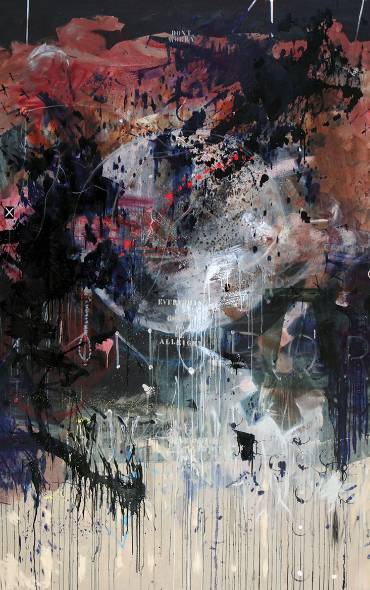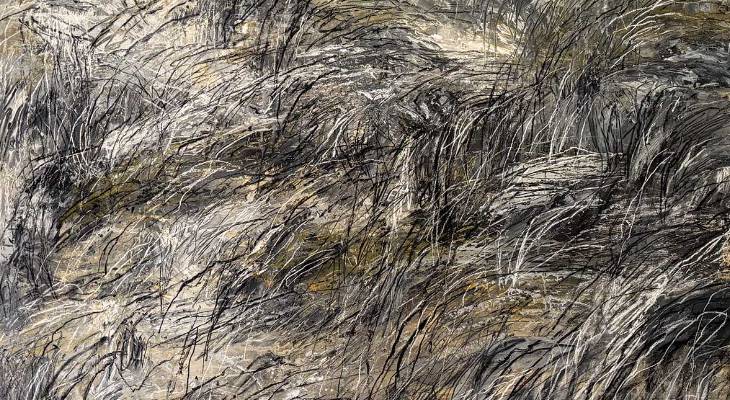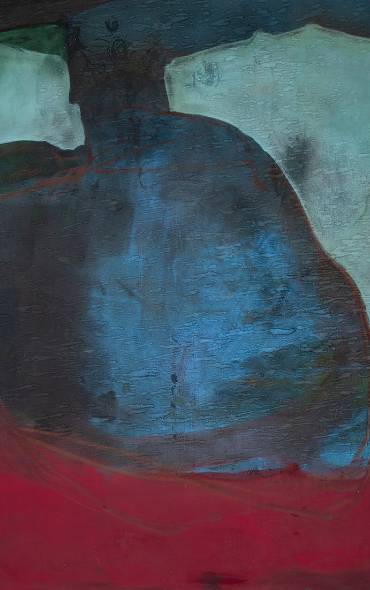The latest major exhibition within Malta International Contemporary Arts Space (MICAS) turns a keen focus on the vibrant talent within the Maltese art scene. MICAS Artistic Director EDITH DEVANEY delves into the vision behind this significant showcase and explores the diverse voices shaping contemporary art in Malta today.

Austin Camilleri, You used to be so definite, 2010.
Courtesy of MICAS
Malta International Contemporary Arts Space (MICAS), in Floriana, has swiftly cemented its position as the leading institution for contemporary arts on the island, following its impressive inauguration with internationally acclaimed Portuguese artist Joana Vasconcelos. Now, MICAS is turning its focus inwards, dedicating its stunning Floriana galleries to a pivotal group exhibition titled The Space We Inhabit, showcasing the depth and diversity of Malta’s own contemporary artists.
The Space We Inhabit, which opened on Saturday 14th June, occupies all three levels of the custom-fitted gallery space, in what MICAS Artistic Director Edith Devaney considers a significant moment for both the institution and the Maltese art scene.
The Artistic Director explains that following the initial international spotlight, the intention was always to dedicate substantial programming to local talent. The Space We Inhabit, she reveals, is built around a compelling concept: that of imagined space. “This exhibition includes artists from different generations, with art pieces – some of which have never been exhibited before, some being specifically created for the MICAS show – selected and installed around the concept of imagined space.”
She goes on to elaborate on the sheer variety of artistic approaches, affirming, “these artists are working across differing media, and their work illustrates the depth and richness of contemporary art practice in Malta.” The exhibition, she adds, will also mark a key phase in MICAS’s ongoing vision: “The Space We Inhabit also marks the beginning of regular exhibitions within the MICAS programme that explores and showcases Malta-based art within a global context.”
This commitment to documenting and platforming Maltese contemporary art is evident in MICAS’s prior initiatives, such as showcasing the final commissioned work by the late Maltese artist Ray Pitrè, ‘Figure in Rods’, meticulously documented from genesis to completion. Edith also speaks with palpable enthusiasm about this direction, affirming, “MICAS is thrilled to be able to celebrate Maltese art at its highest form, bringing it to a wider international stage and contextualising it within the overall exhibition programme.”

Vince Briffa, Cerco Lingua, 2024. Courtesy of MICAS. Photo: Dragana Rankovic
The exhibition features six distinct voices that, collectively, offer a panoramic view of the contemporary landscape. The Artistic Director guides us through the artists involved, each contributing a unique perspective to the notion of The Space We Inhabit.
First, there’s Caesar Attard (b. 1946), a veteran figure who has remained consistently active in the Maltese art scene since 1969, participating in exhibitions in Malta and abroad, as well as teaching visual art and history at the Junior College of the University of Malta. Besides painting, Attard has experimented in non-traditional art-forms such as participatory art and installations since the 1970s, with more recent significant works shown in group shows including a participatory art event and installation entitled B/s/b at Human Matter at the Malta Society of Art, Valletta in 2017; the exhibition rajt ma rajtx – naf li rajt at Valletta Contemporary, Valletta in 2021; and Life & Passion Revisited at Valletta Contemporary, Valletta in 2024.
The second participating artist, Prof. Vince Briffa (b. 1958), brings a multimedia, cross-disciplinary perspective. As a multimedia artist, curator and researcher, his cross-disciplinary and trans-mediatic work consists of gallery and site-specific artwork, sculptural objects, video, and installations. Prof. Briffa has been the recipient of a number of art residencies, including the sculpture studios at the Edinburgh College of Art, Scotland in 1996, the Leeuwarden Capital of Culture in 2018 and the Ranieri Castle in Umbria in 2018, among others. He was also awarded the prize Omaggio all’Arte ed all’Innovazione a Venezia 2019 by the Union of Honorary Consuls of Italy (UCOI) and the National Association of Young Innovators (ANGI) at the 2019 Venice Art Biennale.

Anton Grech, Untitled, 2005 Courtesy of MICAS.
Photo: Julian Vassallo.
Austin Camilleri (b. 1972), meanwhile, is presented as an artist of remarkable versatility, working simultaneously and non-hierarchically in installation, painting, drawing, video, and sculpture. Drawing mainly on Western art history, popular culture and power image traditions, he explores the tension between the material and the digital, the personal and public, by layering techniques and modalities.
Camilleri’s extensive international exhibition history includes participation in the Venice Biennale, Ostrale Biennale in Dresden, Mediterranean Biennale in Tunis, ArtRaker Biennale in Valletta, the Biennale for Young Artists in Rome, and Art Knows no Frontiers in Trier. Beyond his own practice, he has also curated contemporary shows and worked with choreographers, musicians, authors, and theatre practitioners in many collaborative projects. His work is not only published in books and publications internationally but is also found in public spaces, as well as public, corporate and private collections worldwide.
Participating artist Joyce Camilleri (b. 1980), a member of the Department of Visual Arts of the Faculty for the Built Environment at the University of Malta, also runs the Jo Borg Gallery in Sliema. Her artistic practice is deeply rooted in drawing and printmaking, both of which inform her painting method, with work that pushes the boundaries of graphic elements, creating representational and quasi-abstract visual metaphors that blur the line between the real and the imaginary.
Camilleri explores visual concepts of poetic space through ongoing material research, with an emphasis on artistic process rather than subject matter. Artistic intent and process-led practices remain interchangeable within her work. Moreover, her pieces are already part of significant permanent collections, including MUŻA – the Malta National Community Art Museum, as well as the NI Institute and Museum Bitola in North Macedonia.
Next in the acclaimed list is Anton Grech (b. 1965), who studied at the Malta School of Art, at the Accademia di Belle Arti di Firenze and at the Kunstakademie Düsseldorf where he was a member of the artistic academic staff, and now teaches at the Malta School of Art and at the University of Malta, where he is Head of the Department for Visual Arts within the Faculty for the Built Environment.
He is known for both public sculpture – such as Argos, a public sculpture for the Cottonera Waterfront (2008) – and his insightful drawings shown in personal exhibitions including Anton Grech, Drawings at the National Museum of Fine Arts, Valletta (2005-2006); Anton Grech at the Konrad Adenauer-Stiftung, Berlin, Germany; Anton Grech, Pittura at Vilhena Palace, Mdina (2001) and Anton Grech, Malerei at Ballhaus, Düsseldorf (1999). Grech has represented Malta across Europe and in China in several exhibitions of his work.
Finally, Pierre Portelli (b. 1961) works primarily in installation, sculpture, video, and mixed media art. He explores and makes use of various media, including new technologies and repurposed objects, among others, to investigate processes of change, interaction and the temporary meeting of social worlds through sculpture, site-specific work, language, and sometimes playful tongue-in-cheek undertones.
Portelli has originated cross-disciplinary research-based projects with music composers and performers, choreographers, actors and authors, and is a frequent collaborator in theatre productions. He is also a key figure in significant cross-disciplinary research projects, notably the ongoing REL•INK Indelible Narratives project initiated in 2016, which researches and explores the tattoo history and narratives of Malta and its links with other Mediterranean port cities.
This carefully curated selection, MICAS’s Artistic Director explains, provides a rich tapestry of contemporary Maltese creativity. By bringing these distinct practices together under the unifying concept of imagined space, The Space We Inhabit not only showcases the individual but also fosters a dialogue about the collective artistic consciousness of the island.
Ultimately, The Space We Inhabit invites audiences to engage with profound artistic explorations within the stunning setting of MICAS, making for an essential visit for anyone keen to understand the dynamic and evolving landscape of Maltese contemporary art as it takes its place on the international stage.
www.micas.art
This article first appeared on Guide Me 2025.